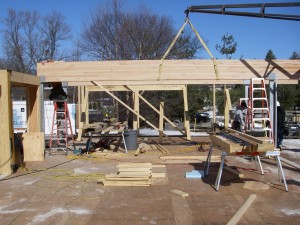 The credit is a prerequisite, and requires that we limit the overall estimated waste factor to 10% or less. Waste factor is defined as the percentage of framing material ordered in excess of the estimated material needed for construction.
The credit is a prerequisite, and requires that we limit the overall estimated waste factor to 10% or less. Waste factor is defined as the percentage of framing material ordered in excess of the estimated material needed for construction.
I have had to re-read this credit several times, because I could not get it through my head that it was not about actual waste factor. It only addresses what apparantly is a common issue with builders, and that is that they order too much wood for a particular job and end up wasting it. Hmmm….a LEED credit that would actually save the homeowner money rather than cost more. I like this one!
Another interesting part of this credit is that it assumes the home will be wood-framed. Indeed, because of its versatility, ease of construction, and relatively low price, wood frame construction is the number one system of building homes in North America. When we began the project, we wanted to explore building our home using an Insulated Concrete Form (ICF) called Durisol, which was recommended to us by Oram Miller, a local healthy home consultant. It is made primarily of recycled concrete and is meant to “breathe” — so you assume there will be moisture getting into the walls of the house, but the walls can dry out. There should be no vapor-barrier used with this type of material, and that could be a code violation. Not surprisingly, our builder and architect were adamantly united against this, primarily because wood allows for better and easier custom design, it is less expensive than ICFs, and they have had much more experience using wood. In the end, we felt we had to go with their recommendation.
For all the wood framing materials, Shaw / Stewart Lumber Company was our supplier. The project manager for our job told me over the phone that they always estimate for a 5% waste factor, which is clearly well below the 10% requirement. Additionally, many of the wood pieces ordered were pre-fabricated off-site (such as the glu-lams used for framing, shown in the photo), which means that waste factor on-site would be 0%. So, even if I created a table that showed the weighted-average waste factor of each framing component (as this LEED credit requires), it would be less than 5%.
